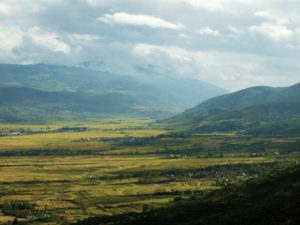Rebecca Harms was 18 when she started campaigning for solutions to nuclear waste-storage in Germany. The Green Party MEP is now nearing her 56th birthday, but the country isn’t any closer to burying its radioactive waste. Last year – after decades of on-off drilling at the site of an old salt dome in north Germany and more than a billion euros of public money spent – the federal government announced it was starting from scratch with its search for a suitable site for a “deep geological repository” in which to store spent fuel.
Germany is not alone. “None of the countries which started to use nuclear fission for power production 50 years ago have an acceptable solution for nuclear waste and final storage. None,” Harms says wearily, speaking on the telephone from Brussels. Though she is firmly against nuclear power, Harms is strongly in favour of building a geological repository in Germany; essentially a giant cavern in the bedrock, in which the country’s high-level radioactive waste can be sealed away while its isotopes decay over hundreds of thousands of years (in fact, regulations dictate that the repositories guarantee safety for up to a million years). “I’ve been working on this for decades and I’m convinced it is the best way,” she says.
Many others agree. Several countries are planning to build deep repositories of their own. But their plans keep hitting bumps. This month, confidence in the UK’s scheme was undermined when the three councils in the running to host the waste got cold feet and postponed a decision to allow test drilling at the last minute. And in 2010, the US Energy Department pulled the plug on the Yucca Mountain storage facility in Nevada – after spending more than US$12 billion building it – on grounds opposition to the project had made it unworkable.
Even in Scandinavia, the region furthest along in the process, there are still uncertainties. Finland is expected to open the world’s first repository at Onkalo by 2020, and neighbouring Sweden expects to start building its repository in 2017. But a Swedish scientist has recently raised alarm about the stability of the copper casks that will be used to contain the waste. Waste disposal company SKB is conducting lab tests in response.
Nuclear waste is the problem that won’t go away – literally. Even if the world stopped all nuclear projects now, it would still have to deal with the legacy of past operations. Globally, there are around 270,000 tonnes of high-level waste in temporary storage, to which 10,000 tonnes are added each year, according to World Nuclear Association (WNA) figures.
Getting it underground isn’t actually urgent. Spent fuel needs decades to cool down before it can be moved to long-term storage, and some of it gets reprocessed anyway. But piles of waste sitting around in interim storage with no ultimate solution in sight is at the very least politically uncomfortable, particularly in the wake of last year’s meltdown at Fukushima, where an unstable spent fuel pond significantly complicated recovery efforts. Chairman of the Japan Atomic Energy Association called it the biggest single threat to the plant.
Let’s bury the waste – but where?
Governments realise this, which is why many are trying to do something about it – in Europe, there is extra pressure thanks to new rules requiring EU member countries to put a long-term plan for dealing with nuclear waste in place by 2015. Though more off-beat ideas like burying waste in the sea-bed are floating around, the hole in the ground approach is the favoured option. As long as it’s located under the right kind of rock, and in a seismically stable area, the consensus says this is a safe way forward: bury all the waste in one very secure location and be done with it.
But where? That’s where things get sticky.
In Germany, many of the present problems stem from the opaque manner in which the siting process was conducted, starting in the 1970s, says Harms. Government secrecy and a string of decisions perceived to have put politics over safety have contributed to public mistrust (80% of the population is anti-nuclear) and resulted in a parliamentary probe. In September this year, Angela Merkel herself was questioned by the inquiry over whether or not she had lied to the public in the 1990s about the suitability of the site selected for the repository by the government, Gorleben.
The German magazine Spiegel details how drilling teams first arrived in Lower Saxony in 1976, claiming to be searching for oil, when in fact they were checking out former salt domes as potential nuclear storage sites. When locals worked it out, protests erupted as dairy farmers feared their milk would be contaminated. Later, the government decided to focus on Gorleben alone – a relatively unpopulated area where protests were deemed less likely, but about which geologists held serious concerns. Among other things, the salt dome lay near natural gas deposits, raising fears about potential future explosions, according to Spiegel. “Previously unknown documents and interviews with contemporary witnesses already reveal that instead of geology and nuclear physics, partisan politics and power struggles shaped the search for permanent repositories from the start,” the magazine said in 2010.
Crisis at an existing nuclear waste storage site – the Asse II salt mine, which is in danger of collapse – further fomented public concern. And in November 2011, the government said it would restart the search for a permanent waste dump.
Three decades of wrangling has taken its toll: an employee at utility EnBW told me Germany’s utilities had spent around 1.5 billion euros on research at Gorleben. The nuclear utilities were so annoyed by apparent back-tracking from the project in the early 2000s that they refused to participate in roundtable talks about the search for a new site; hardly a triumph for open dialogue.
Volunteering for nuclear dumps
While Germany’s story has been shrouded in secrecy, Sweden and the UK have taken public participation to an extreme – by inviting communities to volunteer to host repositories.
In Sweden, this approach has been a great success, says Jenny Rees, a spokesperson for SKB, the company tasked with disposing of the country’s nuclear waste.
After a very lengthy public consultation process, dating back to the 1970s and involving regular meetings, residents groups, tours of their facilities and more (“people would invite us home to their kitchen tables”), the country has a municipality signed up to host the repository, in which local people voted for the project in a referendum. An application for a licence has been filed and – provided concerns over copper don’t waylay plans – SKB hopes to start building in 2017. The latest opinion poll commissioned by the company put local support for the scheme at 80%.
“Every country of course has to decide for themselves how they would like to do this, but what I can say is this has worked for us. I would say be as open as possible, listen, open up your facilities and make time for questions,” says Rees.
Other countries have, of course, taken note, including the UK. But early signs suggest the process may not work so smoothly there, thanks to a worryingly small pool of volunteers. In September, Shepway council in the south of England dropped out as a contender after a survey showed 63% of residents didn’t want it. The final three councils, all in the northern county of Cumbria, where there is a nuclear plant already, have put off making a decision. Even if they go ahead, there will be uncertainties – the local geology could turn out to be unsuitable, for instance. Could this level of public engagement turn out to be a mistake?
“Clearly with anything, if you’ve got the community on side, it enables the project to move forward. But the technical issues around a repository are very significant and it does narrow down the choices,” says one consultant working on the scheme, who asked to remain nameless. “This is the process they’ve decided to go down, but if that’s not forthcoming, they need to revisit that strategy.”
Keeping the fuel above ground
Not everyone believes it’s necessary to bury nuclear waste at all. “I’m a sceptic that any of this stuff needs to be buried underground as if it was a huge threat to humanity,” says pro-nuclear environmentalist Mark Lynas. “It’s a legacy of irrational policy that anti-nuclear groups have fomented for decades. I don’t think any living thing – animal, plant, human – has ever been harmed by nuclear waste nor is likely to be.”
Rather than argue about where to site repositories, a debate “that is always going to be poisonous”, governments should focus their efforts on recycling spent fuel, says Lynas. Technology to do this, the fast prism reactor, is currently under government review in the UK.
Senior figures in the nuclear industry agree that moving ahead with recycling is key to a nuclear future. Speaking at a WNA conference in September, Kevin Walsh, senior vice-president at GE Hitachi, the firm behind the fast prism reactor, said: “For generations, our industry has viewed this material as an inconvenience. It’s possibly the biggest single reason environmental groups haven’t embraced nuclear as the clean energy we believe it to be.”




